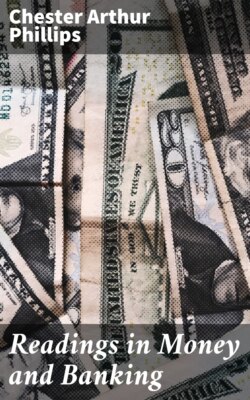Читать книгу Readings in Money and Banking - Chester Arthur Phillips - Страница 70
На сайте Литреса книга снята с продажи.
Wherein Peculiar
ОглавлениеTable of Contents
[22]Although the specific measure passed in 1878 thus rested on a long train of historical causes, it contained details that were essentially new, not only in our own experience, but in that of the world at large. … It … provided for a regular mechanical addition of large amount to the general circulating medium. No precise experiment of this kind had ever been tried. It is true that Germany and the countries of the Latin Union possess, in their circulating medium, large quantities of overvalued thalers and five-franc pieces which are exactly like our silver dollars. They also are legal tender without limit; their total quantity is limited; and it is only by this limitation of the quantity that their value is kept above that of the bullion contained in them. But the thalers and francs in these countries are not new additions to the currency. They are remnants from an earlier period, when Germany had a silver standard, and the Latin Union a complete bimetallic standard. No addition whatever to the thalers is made in Germany; and if some coinage of five-franc pieces takes place in France and in other countries of the Latin Union, the additions are meant merely to fill the place of abraded coins, to provide for the ordinary losses from daily use, and to make any additions to the supply which may be needed for convenience in making small change. No other country has ever entered on an addition of overvalued coin to its circulating medium having the object and extent of that made by our silver act of 1878. This characteristic of the measure, it need hardly be said, was the result not of any deliberate intention to try a new experiment, but of the spirit of compromise which explains so many anomalies in the legislation of democratic communities. The silver act, as passed by the House of Representatives, provided for complete bimetallism—for the free and unlimited coinage of the silver dollar at the old ratio of 16 to 1. In the Senate, it was amended by the substitution of the provisions for a limited coinage, which were finally enacted. The compromise was meant to satisfy both those who objected to the cheaper standard and those who wanted more money; and it afforded a welcome escape to the legislators who were trying to satisfy all parties. At the time, no one probably expected that the measure would remain in force for any great length of time. The conservative element hoped that it would be repealed after a short trial; the inflationists (for by that name they might, then at least, fairly be called) believed that it would soon be superseded by the free and unlimited coinage of silver. As it happened, the act remained in force, unamended, and indeed without very serious attempt at amendment, for over twelve years; and the measure which succeeded it in 1890, though different in many details, followed the same method of forcing a large regular injection into the circulating medium of money based on silver purchases by the Government.
